Incremental backup on the fly using Quick Backup - a new feature of Veeam Backup & Replication v8
What most often do users who need to urgently get a backup of the virtual machine, for example, to test and debug a hotfix? Judging by our observations, most often they do snapshots. In fact, the snapshot has enough advantages: its creation does not take much time, and if something goes wrong, you can quickly roll back the virtual machine to its previous state. However, there are also disadvantages: while you experiment with the machine, the snapshot grows; virtual machine has poor read / write performance; reduced storage space on the storage system. In addition, “forgotten” (orphaned) snapshots can also cause trouble - it’s not for nothing that VMware recommends monitoring the relevance and length of the snapshot chain of a virtual machine. As a result, there is a risk that, due to the overgrown snapshots, there will be problems with the availability of production resources (in particular, due to the excessive intensity of reading / writing on the storage system), and during the commit the virtual machine will simply hang.
To avoid these troubles, it is wise to use a virtual lab, or sandbox (for example, as recommended here ) for all kinds of testing. But its launch and configuration take time, but what if there is just enough?
You can start the backup process - but it also lags behind the snapshot creation speed even if you use the free VeeamZIP utility (creating a full backup for the selected virtual machine on the fly, that is, on demand and without stopping the machine). Passing an incremental backup is also not always a salvation - for example, if a virtual machine backs up in one task with several more, then when you start this task you will have to wait until they are all processed.
')
For such cases, Veeam Backup & Replication 8.0 - Quick Backup, which creates an incremental restore point for the selected virtual machine on the fly, is very useful.
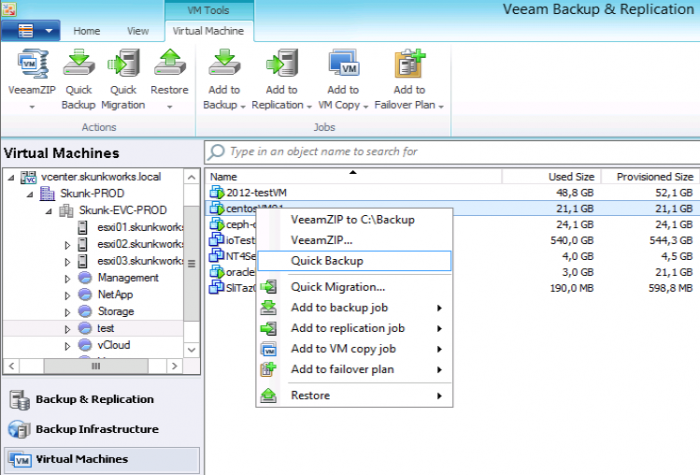
What is this kind of backup, and why it is named Quick - we understand under the cut.
When you start Quick Backup, Veeam Backup & Replication searches for the recovery point for the selected virtual machine (it doesn't matter if it was created by a backup task that includes one or several machines).
If at least one recovery point is found, then the backup task that created it will start an incremental (relative to this point) backup run. At the same time, regardless of how many virtual machines are included in the task, an increment will be created only for the selected machine. (Note that the chains are supported for both the direct incremental and the reverse incremental backup method).
I foresee the question: what if this virtual machine is processed by several tasks? Then the freshest of the created restore points will be selected and the corresponding task will be launched.
The increment file (.VIB or .VRB) will contain only the changed blocks for the selected virtual machine, so its creation will take a little time. No additional parameters are required; the settings of the original task will be used, including the path to the repository (the increment created by Quick Backup will be saved to it as well). It is important to note that such task settings as storage periods and the number of saved recovery points will not fail: an “additional” point will be created, which, firstly, will not be included in the counted recovery points, and, secondly, will be deleted along with the point that served as the starting point for it (i.e., according to the storage settings, as described here ).
You can launch Quick Backup from the Veeam Backup & Replication console with a flick of the wrist: in the Virtual Machines view, select the virtual machine in the tree for which you want to start an incremental backup, then select the Quick Backup command from the context menu for the right:

To make life easier for vSphere administrators and not to force them to access different consoles for different tasks, you can launch Quick Backup directly from the popular VMware vSphere Web Client — for example, go to the Actions menu in our virtual machine and then select Backup> Quick Backup :
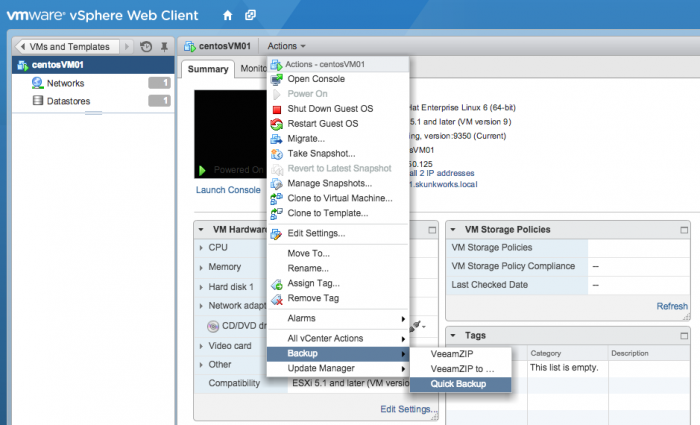
The progress of the incremental backup is displayed in the Recent Tasks panel:
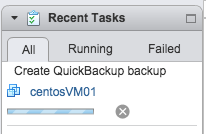
If you open the Veeam Backup & Replication console at the same time, you can see that the corresponding backup copying task started and works:
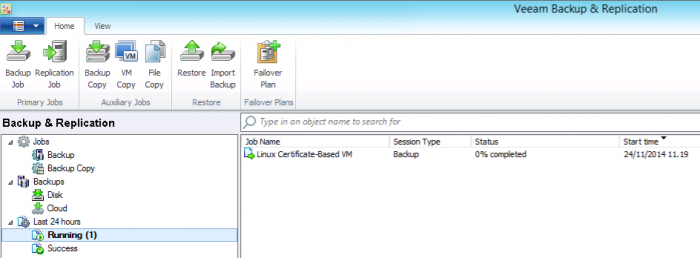
The VMware administrator can, of course, not switch to the second console - when the creation of the recovery point is completed, he will know about it from the notification in the web client panel:
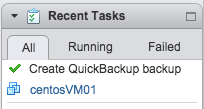
You can learn more about integrating Veeam Backup with the vSphere web client that has gained popularity here .
You can recommend Quick Backup to quickly create a restore point of the selected virtual machine, after checking whether the following conditions are met:
To avoid these troubles, it is wise to use a virtual lab, or sandbox (for example, as recommended here ) for all kinds of testing. But its launch and configuration take time, but what if there is just enough?
You can start the backup process - but it also lags behind the snapshot creation speed even if you use the free VeeamZIP utility (creating a full backup for the selected virtual machine on the fly, that is, on demand and without stopping the machine). Passing an incremental backup is also not always a salvation - for example, if a virtual machine backs up in one task with several more, then when you start this task you will have to wait until they are all processed.
')
For such cases, Veeam Backup & Replication 8.0 - Quick Backup, which creates an incremental restore point for the selected virtual machine on the fly, is very useful.

What is this kind of backup, and why it is named Quick - we understand under the cut.
How it works?
When you start Quick Backup, Veeam Backup & Replication searches for the recovery point for the selected virtual machine (it doesn't matter if it was created by a backup task that includes one or several machines).
If at least one recovery point is found, then the backup task that created it will start an incremental (relative to this point) backup run. At the same time, regardless of how many virtual machines are included in the task, an increment will be created only for the selected machine. (Note that the chains are supported for both the direct incremental and the reverse incremental backup method).
I foresee the question: what if this virtual machine is processed by several tasks? Then the freshest of the created restore points will be selected and the corresponding task will be launched.
The increment file (.VIB or .VRB) will contain only the changed blocks for the selected virtual machine, so its creation will take a little time. No additional parameters are required; the settings of the original task will be used, including the path to the repository (the increment created by Quick Backup will be saved to it as well). It is important to note that such task settings as storage periods and the number of saved recovery points will not fail: an “additional” point will be created, which, firstly, will not be included in the counted recovery points, and, secondly, will be deleted along with the point that served as the starting point for it (i.e., according to the storage settings, as described here ).
What button to press?
You can launch Quick Backup from the Veeam Backup & Replication console with a flick of the wrist: in the Virtual Machines view, select the virtual machine in the tree for which you want to start an incremental backup, then select the Quick Backup command from the context menu for the right:

To make life easier for vSphere administrators and not to force them to access different consoles for different tasks, you can launch Quick Backup directly from the popular VMware vSphere Web Client — for example, go to the Actions menu in our virtual machine and then select Backup> Quick Backup :

The progress of the incremental backup is displayed in the Recent Tasks panel:

If you open the Veeam Backup & Replication console at the same time, you can see that the corresponding backup copying task started and works:

The VMware administrator can, of course, not switch to the second console - when the creation of the recovery point is completed, he will know about it from the notification in the web client panel:

You can learn more about integrating Veeam Backup with the vSphere web client that has gained popularity here .
Total
You can recommend Quick Backup to quickly create a restore point of the selected virtual machine, after checking whether the following conditions are met:
- This virtual machine must be included in the backup task on the Veeam Backup & Replication server (to run Quick Backup from the product console; to run from VMware vSphere web client, this server also needs to be added to Veeam Backup Enterprise Manager, which will enable integration with vSphere Web Client)
- There must be a full backup for this machine (i.e., the .VBK file in the corresponding repository) created when the backup task was successfully executed.
Additional Information:
- Article on Habré about backup methods and backup storage time: http://habrahabr.ru/company/veeam/blog/242983/
- An article on Habré on how to deal with "orphan" snapshots and other problems of running a virtual farm: http://habrahabr.ru/company/veeam/blog/238167/
- An article on Habré about working with VMware vSphere Web Client and using the Veeam Backup & Replication plugin for this web client: http://habrahabr.ru/company/veeam/blog/183882/
- Review of Veeam Backup & Replication 8.0 (demo from the laboratory, in Russian): http://www.veeam.com/resource-library.html?prod=vbr&c_type=all&hyperv=all&cat=all&app=all&lang=ru
Source: https://habr.com/ru/post/248353/
All Articles